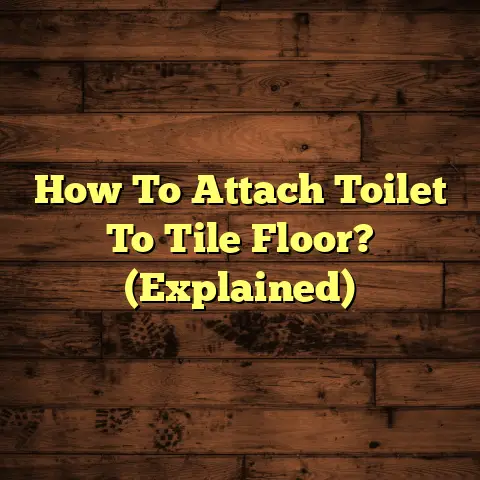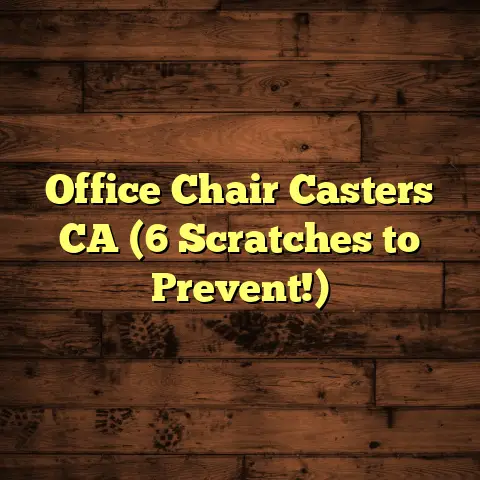Asbestos in Concrete Floors? (1 Urgent CHECK!)
As a flooring contractor with years of experience, I’ve seen firsthand the problems asbestos can cause, especially when it’s lurking beneath your feet in concrete floors.
Asbestos is no joke.
We’re talking about serious health risks like lung disease and cancer.
And guess what?
It’s way more common than you think, especially in older buildings.
That’s why I’m writing this – to give you the straight facts and quick solutions if you suspect asbestos in your concrete floors.
Let’s dive in and get you the info you need to protect yourself and your family.
Section 1: Understanding Asbestos in Concrete Floors
Okay, first things first: what is asbestos?
Asbestos is a group of naturally occurring minerals that were super popular in construction for, like, ever.
Why?
Because it’s fire-resistant, strong, and cheap.
Think back to the mid-20th century.
It was used in everything from insulation to roofing to, you guessed it, concrete floors.
The Danger Zone: Airborne Fibers
Here’s the deal: asbestos is only dangerous when it’s disturbed.
When asbestos-containing materials are damaged or break down, tiny fibers can become airborne.
If you breathe those fibers in, they can get stuck in your lungs, leading to some nasty health problems.
We’re talking:
- Asbestosis: Scarring of the lungs.
- Lung Cancer: Need I say more?
- Mesothelioma: A rare and aggressive cancer affecting the lining of the lungs, abdomen, or heart.
Trust me, you don’t want any of that.
Where Asbestos Hides in Concrete Floors
So, where exactly might asbestos be hiding in your concrete floors?
Here are a few common culprits:
- Floor Tiles: 9×9 inch tiles are notorious. They often contain asbestos.
Mastic (Adhesive): That black, sticky stuff holding the tiles down?
Yup, that can have asbestos too.
* Concrete Mix: In some cases, asbestos was even mixed directly into the concrete itself.
The Legal Lowdown
Now, let’s talk about the legal stuff.
There are regulations in place to protect you from asbestos exposure.
In the US, the EPA (Environmental Protection Agency) sets the rules.
These regulations cover everything from testing to removal to disposal.
It’s crucial to be compliant.
Not only for your health but also to avoid hefty fines and legal trouble.
Section 2: Identifying Asbestos in Your Concrete Floors
Alright, let’s get practical.
How do you know if you’re dealing with asbestos?
Unfortunately, you can’t just look at a floor and know for sure.
But here are some clues to watch out for:
Visual Inspection: A First Look
Age of the Building: Was your house built before the 1980s?
That’s a red flag.
* Tile Size: As I mentioned, 9×9 inch floor tiles are a classic sign.
* Condition: Are the tiles cracked, broken, or coming loose?That means fibers could be getting released.
* Mastic Color: Black mastic is more likely to contain asbestos than other colors.
Warning Signs
Besides the visual clues, here are some other things that might make you suspicious:
- Dust: If you’re doing renovations and notice a lot of dust, especially if the flooring is old, be cautious.
-
Health Issues: Have you or anyone in your family been experiencing unexplained respiratory problems?
It’s worth getting your home tested.
The Importance of Professional Testing
Here’s the thing: you can’t rely on guesswork when it comes to asbestos.
The only way to know for sure is to get your flooring tested by a certified lab.
Here’s how it works:
- Sampling: A trained professional will carefully take samples of the flooring material.
- Lab Analysis: The samples are sent to a lab where they’re analyzed under a microscope to identify asbestos fibers.
- Results: You’ll get a report detailing whether or not asbestos is present and, if so, what type and concentration.
Finding a Certified Asbestos Inspector
Okay, so how do you find a qualified inspector?
Here are a few tips:
- Check Certifications: Make sure the inspector is certified by a recognized organization.
- Ask for References: A reputable inspector should be able to provide references from past clients.
- Verify Insurance: Ensure the inspector has adequate liability insurance.
- Check with Local Authorities: Your local health department may have a list of licensed asbestos professionals.
Section 3: Fast Solutions for Handling Asbestos in Concrete Floors
Okay, so you’ve tested your floors, and the results came back positive.
Don’t panic!
There are solutions.
Let’s talk about some immediate actions you can take to protect yourself and your family.
Immediate Actions
Seal Off the Area: If the flooring is damaged, the first thing you want to do is prevent any further fiber release.
Close off the room, cover doorways with plastic sheeting, and use duct tape to seal the edges.
2.
Avoid Disturbance: This is crucial.Don’t sweep, vacuum, sand, or do anything else that could disturb the flooring.
That will only release more fibers into the air.
3.
Wet Cleaning: If you need to clean the area, use a wet mop and a mild detergent.This will help to trap any loose fibers.
4.
Wear Protective Gear: If you must enter the area, wear a respirator mask (N-95 or higher) and disposable gloves and clothing.
Professional Abatement Options
Now, let’s talk about the pros.
These are the experts who can safely remove or contain the asbestos.
Here are two main options:
Encapsulation: This involves sealing the asbestos-containing material with a special coating.
The coating prevents fibers from being released.
Encapsulation is a good option if the flooring is in relatively good condition and you don’t want to remove it.
It’s generally less expensive than full removal.
2.
Full Removal: This is exactly what it sounds like: removing the asbestos-containing material entirely.This is the most effective way to eliminate the risk of exposure.
However, it’s also the most expensive and disruptive option.
The process typically involves:
- Sealing off the work area.
- Using specialized equipment to remove the flooring.
- Properly disposing of the asbestos-containing waste.
DIY Solutions: Proceed with Caution
Okay, I need to be very clear here: I generally don’t recommend DIY asbestos removal.
It’s risky, and if you don’t do it right, you could end up making the problem worse.
That being said, there are some situations where DIY encapsulation might be an option.
For example, if you have a small area of damaged tiles and you’re very careful, you might be able to seal them with a special sealant.
But before you do anything, check your local regulations.
Some areas require professional abatement for any asbestos-containing materials.
If you do decide to DIY, make sure you:
- Wear a respirator mask (N-95 or higher).
- Wear disposable gloves and clothing.
- Follow the sealant manufacturer’s instructions carefully.
- Properly dispose of any waste.
Temporary Solutions: Covering Up
If you need a quick fix and can’t afford professional abatement right away, you might consider installing new flooring over the existing concrete.
This could involve:
- Installing a floating floor, like laminate or vinyl plank.
- Pouring a new layer of concrete over the existing floor.
However, keep in mind that this is only a temporary solution.
The asbestos is still there, and it could become a problem in the future if the new flooring is damaged or removed.
Section 4: Long-Term Solutions and Next Steps
So, you’ve addressed the immediate concerns.
Now what?
Let’s talk about long-term strategies for managing asbestos in concrete floors.
Regular Monitoring
Even if you’ve encapsulated the asbestos, it’s important to keep an eye on it.
Regularly inspect the flooring for any signs of damage or deterioration.
If you notice anything, take action right away to repair it.
Developing a Maintenance Plan
A good maintenance plan can help to prevent asbestos exposure.
This might include:
- Regularly cleaning the flooring with a wet mop.
- Avoiding any activities that could damage the flooring.
- Promptly repairing any cracks or holes.
Full Removal vs. Encapsulation: The Long Game
Ultimately, you’ll need to decide whether to fully remove the asbestos or continue with encapsulation.
Here are some factors to consider:
- Cost: Full removal is more expensive upfront, but it eliminates the risk of future exposure.
- Disruption: Full removal is more disruptive to your home or business.
- Condition of the Flooring: If the flooring is severely damaged, full removal may be the only option.
- Your Peace of Mind: Some people simply feel better knowing that the asbestos is gone completely.
Hiring Licensed Professionals: The Key to Success
I can’t stress this enough: any further work involving asbestos should be done by licensed professionals.
They have the training, experience, and equipment to do the job safely and effectively.
Section 5: Resources and Support
Dealing with asbestos can be overwhelming.
But you’re not alone.
Here are some resources that can help:
EPA (Environmental Protection Agency): The EPA has a wealth of information on asbestos, including regulations, health risks, and abatement procedures.
Check out their website: https://www.epa.gov/asbestos * Local Health Departments: Your local health department can provide guidance and support.
They may also have a list of licensed asbestos professionals in your area.
* Certified Asbestos Professionals: Organizations like the American Industrial Hygiene Association (AIHA) can help you find certified asbestos inspectors and abatement companies.
Conclusion
Okay, we’ve covered a lot of ground here.
Let’s recap the key points:
- Asbestos in concrete floors is a serious health hazard.
- It’s important to identify asbestos-containing materials and take immediate action to prevent exposure.
- Professional abatement is usually the best option for dealing with asbestos.
- There are resources available to help you navigate the process.
The bottom line is this: don’t take asbestos lightly.
If you suspect it’s in your home, get it tested and take the necessary steps to protect yourself and your family.
And please, spread the word about the risks of asbestos in flooring materials.
The more people who are aware, the safer we’ll all be.
Thanks for reading!





